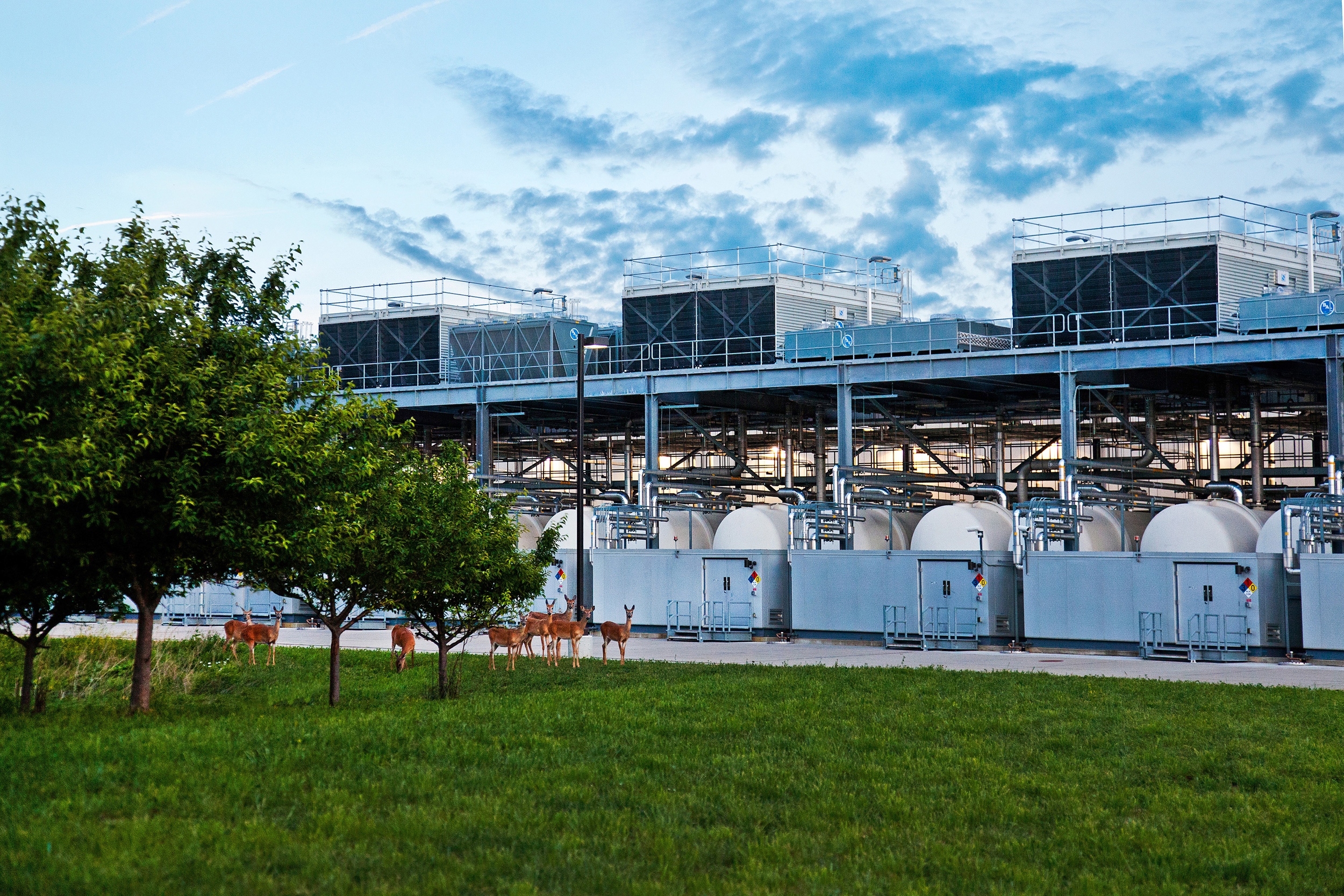Author: ANIKA JANE BEAMER Published: 7/28/2025 Inside Climate News

The state with the highest wind power share in the nation has attracted more than $17 billion in capital investments from cloud computing companies. Experts say rising energy costs could slow that growth.
A line of gnarled elm trees separates Willow Creek Street in West Des Moines from a quintessentially Iowan corn field, deep green at the height of mid-summer.
Across the road, a barbed wire fence borders a sprawling, 10-building Microsoft data center. More and more, this sight is also quintessentially Iowan.
The grid of white warehouses is Microsoft’s Project Alluvion, one of six data centers the tech giant has built in the city of West Des Moines since 2009. Microsoft has invested between $5 billion and $6 billion in these data centers and, last year, announced plans to build a seventh in the region.
Microsoft’s growing West Des Moines empire is part of a larger trend in Iowa, one in which big name cloud-computing companies have flocked to a state rich in corn, hogs and wind energy.
But the One Big Beautiful Bill Act could undermine Iowa’s status as a growing destination for data centers. Cuts to renewable energy incentives laid out in the newly adopted law will increase costs for industrial energy purchasers in Iowa, experts warn, potentially losing the state future investments.
“For consumers like data centers, where a majority of their operational costs go to sourcing energy, that’s going to have a huge impact on where they decide to site their centers,” said Dan O’Brien, a senior modeling analyst at Energy Innovation, a nonpartisan energy and climate policy research firm based in San Francisco.
According to the Iowa Economic Development Authority, 27 data centers are currently operating or under construction in the state. On top of the host of Microsoft centers, Iowa is home to two massive Google data center campuses, two campuses for Facebook parent Meta and, as of last year, one Apple campus. These four companies alone have invested nearly $17 billion into their data centers in Iowa, with Google announcing another $7 billion in investments in its Iowa campuses over the next two years.
What has attracted tech giants to Iowa? Open land, lower construction costs, a recently beefed-up suite of tax exemptions and, above all, cheap, renewable energy, experts said.
Iowa has led the nation in wind energy since 1983, when it became the first state to adopt a renewable portfolio standard, requiring utilities to purchase wind-generated power. In 1993, U.S. Sen. Chuck Grassley (R-Iowa) sponsored the Wind Energy Incentives Act, the first nationwide tax credit for wind energy production.
The state has also implemented property and sales tax exemptions for wind and solar energy equipment, as well as offering zero percent interest loans to individuals or businesses that cover up to half the cost of a renewable energy system.
Iowa’s incentives, paired with the winds that blow unobstructed across its flat, open land as air masses from the Gulf of Mexico and the north collide, led to the exponential rise of wind energy there.
In 2001, that energy accounted for just 1 percent of the state’s electricity mix. By 2010, it made up 15 percent. Wind now accounts for 60 percent of Iowa’s total energy mix—the highest percentage of any state, including Texas, the only state with greater net wind energy generation.
Iowa’s well-developed wind energy offerings draws cloud-computing companies looking to plug into clean energy, said Ryan Moffatt, community and economic development director for the city of West Des Moines, where Microsoft data centers have added $2 billion to the city tax base.

Iowa’s renewable energy is appealing to tech companies looking to meet sustainability goals, said Moffatt. “These big tech companies like to have a focus on renewable energy,” he said.
Google advertises a global goal of net-zero emissions by 2030, while Microsoft aims to be carbon-negative in the same time frame and Meta reports being net-zero since 2020.
This emphasis on renewably sourced energy comes as data centers nationwide face intense scrutiny for their enormous electricity and water consumption. (Microsoft’s data centers in West Des Moines account for 2 to 7 percent of the city’s water use, while Meta centers in nearby Altoona use up to 16 percent of the city water supply. Meta’s Altoona campus consumed about 1.2 million megawatt-hours of electricity in 2023, enough to power 100,000 homes for a year, making it the company’s second most energy-intensive data center. )
In Iowa, where wind energy already comprises a majority of generated electricity, clean energy has been easy to come by.
Google’s Council Bluffs, Iowa, data center campus runs on 95 percent carbon-free electricity, said a company spokesperson. Microsoft matches 100 percent of Iowa data center energy consumption with contracted carbon-free electricity, a spokesperson told Inside Climate News, and the same is also true for Meta.

Wind energy isn’t just readily accessible to data centers, it’s cheap, too. Iowa has the eighth-lowest average electricity prices, according to the U.S. Energy Information Administration. As a result, most data centers in the state have opted to purchase their energy from the grid, as opposed to building their own power plants onsite, the companies told Inside Climate News.
That means they are susceptible to changing utility rates, though. Congress’ rollback of incentives for renewable energy expansion will push costs up, said O’Brien, the Energy Innovation analyst.
Energy Innovation modeled the economic effects of the One Big Beautiful Bill Act’s energy provisions on all 48 states in the contiguous U.S. In Iowa, the group predicted a 14 to 26 percent increase in electricity rates.
“At the top end of that spectrum are industrial consumers,” said O’Brien. “Most of the cost of their power is the actual generation cost itself.” When generation costs go up, he said, it’s industrial consumers like data centers that face the most significant price hikes.